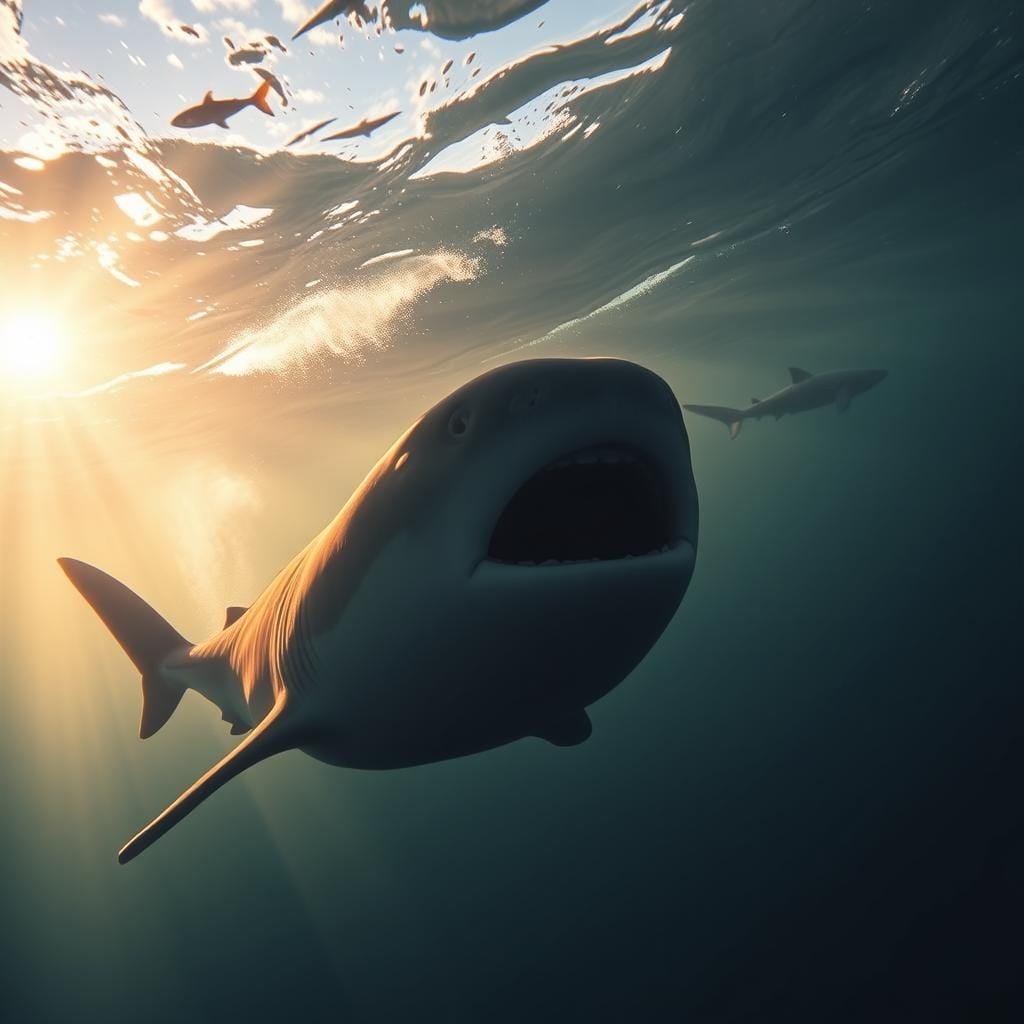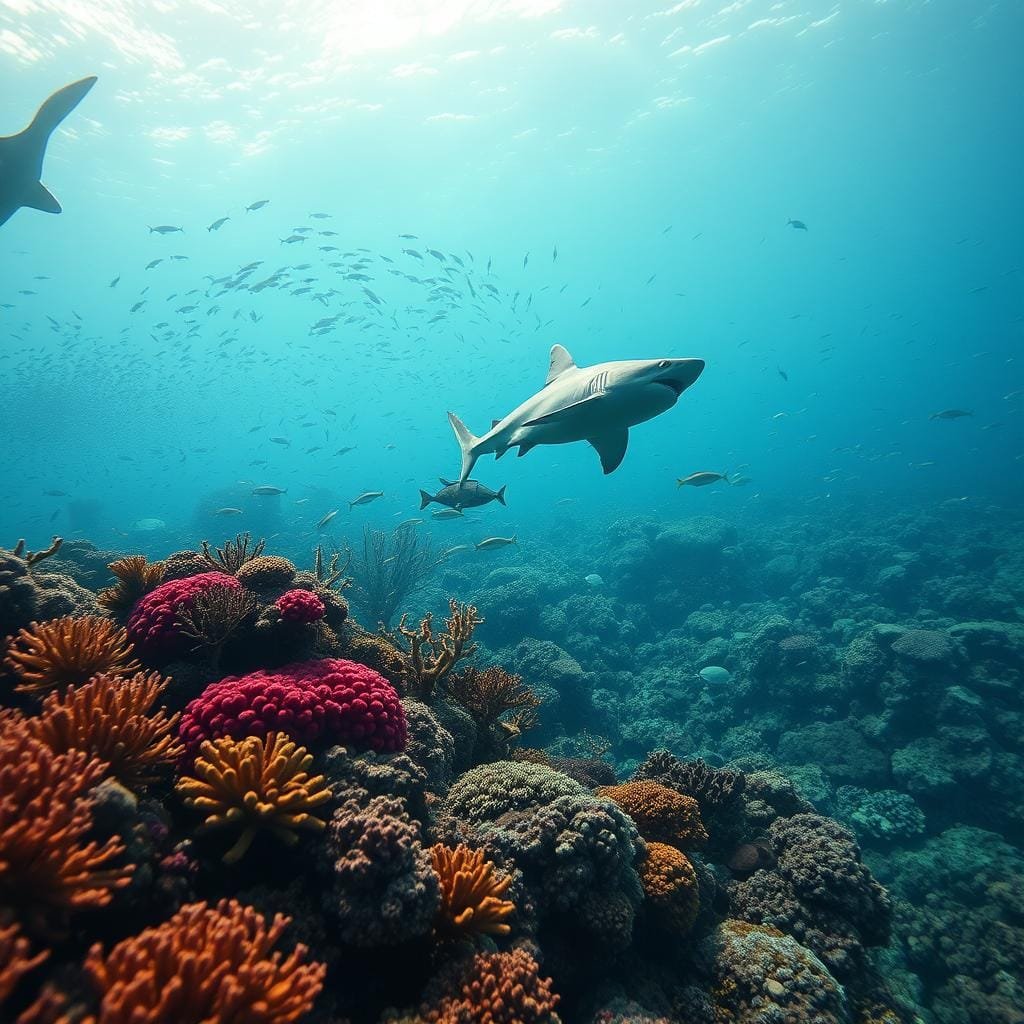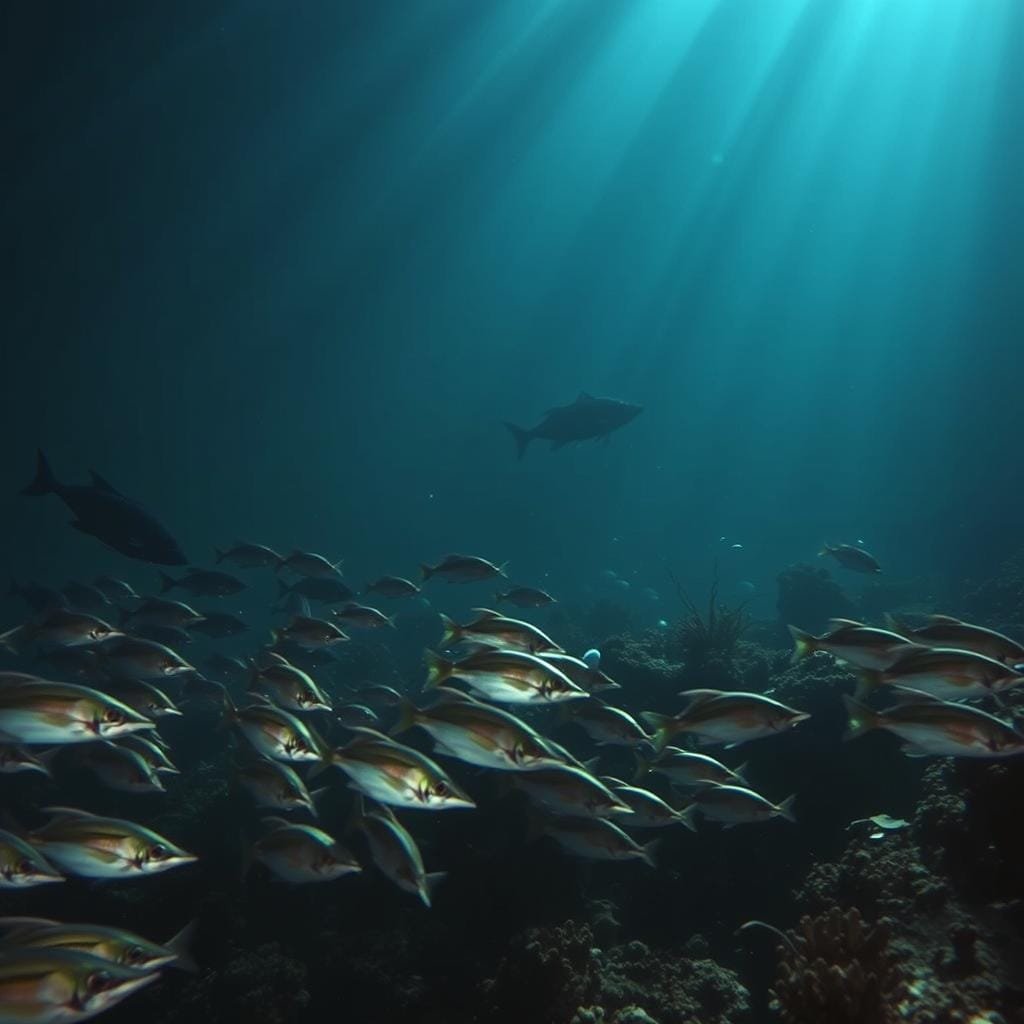Ever wonder what sharks eat? You’re not alone. Sharks roam every ocean, with a diet as vast as the sea. They munch on fish, squid, crustaceans, seabirds, marine mammals, and even other sharks. This variety is why sharks are important to us, keeping our coasts healthy.
Some sharks eat a little bit of everything. Others have their favorite foods. Hammerheads love stingrays, while bull sharks go after other sharks. Smooth dogfish enjoy crabs and lobsters.
Great whites target sea lions and big fish in places like California’s Channel Islands. Tiger sharks, known as the “garbage cans of the sea,” eat turtles, sea snakes, and even carrion. These habits show how sharks eat differently in different places and times.
But sharks aren’t all about big meals. Whale sharks, basking sharks, and megamouths filter huge amounts of plankton. They help keep the ocean balanced. Sharks keep the food web steady by controlling fast breeders and weak animals. This helps prevent big changes in fisheries and beaches, important to us.
How much do sharks eat? In aquariums and the wild, most sharks eat 1%–10% of their body weight each week. A big sand tiger might eat 4–13 pounds in that time. This shows sharks eat efficiently, not constantly. Their diet changes with the sea, showing their smart eating habits.
What sharks eat in the wild: fish, squid, crustaceans, and more
Sharks eat a variety of foods in the wild. Their diet changes based on where they are and the season. They mostly eat fish and squid, but also crustaceans, mollusks, seabirds, and marine mammals.
Common prey across species
Most sharks hunt schooling fish and squid. They also eat crustaceans like crabs and shrimp. The bigger sharks go after marine mammals like seals and dolphins.
How diet varies by habitat and availability
The food a shark eats depends on where it lives. Sharks on the bottom eat crustaceans and mollusks. Coastal sharks eat fish and sometimes sea lions.
In open water, they chase tuna and mackerel. Changes in the ocean can quickly change what they eat. They might switch to eating more crabs in a week.
Why sharks often target weak or injured animals
Sharks hunt for energy. They prefer to eat weak or injured animals because it’s easier. This way, they can get food quickly and move on.
Filter-feeding giants: whale sharks, basking sharks, and megamouths

Three giants rule the ocean’s buffet line. The whale shark, the basking shark, and the elusive megamouth shark don’t chase tuna or seals. They glide with mouths agape, turning the sea into a moving snack bar through plankton filter feeding that fuels their bulk without a fight.
Plankton as primary fuel
Their menu is tiny but rich. Microscopic algae, copepods, krill, and fish eggs anchor the whale shark diet and drive basking shark feeding as well. The megamouth shark also taps dense plankton layers at night, following bioluminescent swarms toward the surface.
Gill rakers vs. spongy filter pads
These giants don’t all strain food the same way. Basking sharks and the megamouth shark deploy gill rakers—thousands of comb-like elements that snag particles and shed when worn. The whale shark relies on flexible filter pads, a spongy mesh braced by cartilaginous rods that trap plankton even when water is murky.
Mind-blowing numbers: 400,000–528,000 gallons filtered per hour
Flow is the secret weapon. A cruising whale shark can clear about 400,000 gallons of water each hour, while a basking shark pushes closer to 528,000 gallons in strong plankton blooms. One haul may yield several pounds of concentrated prey, packed into the gullet in a steady stream.
Reduced, nonfunctional teeth in filter feeders
Because these sharks don’t rip flesh, their teeth are tiny and reduced. The whale shark diet, basking shark feeding strategy, and the approach used by the megamouth shark depend on gill rakers or filter pads, not cutting edges. Water in, food trapped, and the rest flows out through the gills—simple, elegant, and efficient.
| Species | Main Food Source | Filtering Structure | Estimated Water Processed per Hour | Notable Trait |
|---|---|---|---|---|
| Whale shark (Rhincodon typus) | Plankton, fish eggs, small nekton | Spongy filter pads supported by cartilage | ~400,000 gallons | Large mouth funnels dense blooms with minimal effort |
| Basking shark (Cetorhinus maximus) | Zooplankton, small crustaceans | Gill rakers that shed and regrow | ~528,000 gallons | Seasonal fasting likely during raker replacement |
| Megamouth shark (Megachasma pelagios) | Gelatinous zooplankton, krill | Gill rakers with mucous coating | High but variable; nocturnal feeding | Soft, extensible jaws for slow-speed filtration |
Taken together, these adaptations make plankton filter feeding a winning strategy at massive scale. Whether via gill rakers or filter pads, each pass through the water column turns invisible clouds of life into the steady calories that keep these giants cruising.
Shark teeth tell the menu
Looking at shark teeth can tell us what they eat. Each tooth’s shape and edge shows how it helps the shark eat. Sharks often change their teeth to stay sharp for hunting.
Triangular, serrated cutters for slicing marine mammals and big fish
Great white sharks have sharp teeth for cutting through thick blubber and big fish. Their teeth are made for quick cuts, helping them eat without a fight. This is true for many sharks that hunt in the ocean, as explained in this article.
Rounded, serrated “steak-knife” teeth for cracking crustaceans
Tiger sharks have special teeth for eating hard things like turtle shells. Their teeth are like steak knives, helping them eat a variety of food. This lets them adapt to different situations.
Flat, molar-like back teeth for crushing hard-shelled prey
Horn sharks use their front teeth to grab and their back teeth to crush. Rays have even stronger teeth for grinding shells. Their teeth are very wide, showing how they eat hard things.
Rapid tooth replacement and bite force dynamics
Sharks can lose teeth because of strong bites. But they can quickly grow new ones. This keeps them ready to hunt. Some sharks don’t need to bite hard because they use their gill filters to eat.
Species spotlights: who eats what

Sharks don’t eat just anything. Their body shape, teeth, and where they live decide what they eat. Each shark has its own special diet.
Hammerheads favor stingrays
Hammerheads have wide heads full of sensors. They use these to find stingrays in sandy areas. Their special head shape helps them catch rays.
They have sharp teeth to finish off their prey. Divers often find ray barbs where hammerheads feed.
Bull sharks eat other sharks
Bull sharks are strong and live in rivers and coasts. They eat fish and sometimes other sharks. This helps keep the shark population in check.
Smooth dogfish target crabs and lobsters
Smooth dogfish have special teeth for eating shellfish. They look for crabs and lobsters on the bottom. Their teeth help them crush these hard shells.
They hunt at night and work together. This helps them get food from tight spaces.
Great whites prey on sea lions and large fishes
Great whites are fast and catch sea lions and big fish. They eat tuna and mackerel too. They ambush prey near where sea lions live.
Tiger sharks: opportunists and “garbage cans of the sea”
Tiger sharks eat almost everything. They even eat things they shouldn’t. They live in many places, from reefs to open sea.
What they eat changes as they grow. They start with squid and move to bigger prey. Check out this study on Greenland sharks for more.
- Hammerhead diet: mostly stingrays in sandy bays and reefs.
- Bull shark diet: fish, rays, and other sharks in murky rivers and coasts.
- Smooth dogfish diet: crabs and lobsters on the seafloor.
- Great white prey: sea lions and large fishes near rookeries and drop-offs.
- Tiger shark diet: broad mix across habitats, tuned to what’s available.
What does shark eat
Sharks eat a wide range of food, from tiny plankton to big marine mammals. Many sharks eat fish, squid, and crustaceans. Some even eat mollusks, seabirds, and other sharks.
Big filter-feeding sharks like whale sharks filter plankton through their gills. On the other side, great white sharks go after sea lions and big fish. Hammerheads hunt stingrays, and bull sharks eat other sharks.
Tiger sharks are known for eating a lot of different things. They eat turtles, sea snakes, and even garbage. Sharks usually pick weak or injured prey because it’s easier.
Sharks eat about 1% to 10% of their body weight each week. For example, a 289 lb sand tiger shark might eat 4 to 13 lb in a week. This depends on how active they are and what’s available.
| Feeding Mode | Representative Species | Typical Shark Prey | Key Adaptation | Diet Span: Plankton to Marine Mammals |
|---|---|---|---|---|
| Filter feeding | Whale shark, basking shark, megamouth | Plankton, small fish | Gill rakers or spongy filter pads | Near the plankton end of the spectrum |
| Active pursuit | Shortfin mako, great white | Large fishes, sea lions | Streamlined bodies, high-speed bursts | Mid to marine mammals on the spectrum |
| Benthic foraging | Smooth dogfish, horn shark | Crabs, lobsters, hard-shelled mollusks | Crushing back teeth, strong jaws | Middle of the spectrum with crustaceans |
| Opportunistic generalist | Tiger shark | Turtles, sea snakes, fish, carrion | Robust serrated teeth, wide gape | Broad range from fish to marine reptiles |
| Shark-on-shark predation | Bull shark | Other sharks, bony fishes | Powerful bite, estuary tolerance | Toward larger prey on the spectrum |
- Shark diet overview: staples include fish, squid, and crustaceans.
- Shark food list expands with mollusks, seabirds, and other sharks when available.
- Choices often favor weak or injured shark prey to save energy.
- The full arc runs from plankton to marine mammals across species and habitats.
How sharks hunt: tactics and tools

Sharks are fast, sneaky, and know when to strike. They use the currents, light, and fish schools to plan their attack. Their bodies are made for hunting in the open sea and near reefs.
Circling, bumping, and ambush behavior
Sharks circle their prey to figure out its size and position. They might bump it with their nose or fins to see how it reacts. Then, they quickly attack with all their speed.
Jaw protrusion: puncture with lower teeth, slice with upper
Sharks can open their mouths wide to grab their prey. Their lower teeth grab, and the upper teeth cut. This way, they can bite hard and end the chase fast.
Tail-whipping threshers and suction-feeding nurses
Thresher sharks use their tails to herd fish. Nurse sharks suck prey out of tight spots. This helps them catch food in places other sharks can’t.
Cookiecutter “core sampling” from whales and large fishes
Isistius sharks suck onto their prey and twist to take a plug of flesh. This leaves round wounds on big fish and even whales. It’s a unique way to hunt compared to other sharks.
| Tactic | Primary Users | Mechanics | Best Against | Notable Edge |
|---|---|---|---|---|
| Circling and bumping | Great white, bull, oceanic whitetip | Assess prey with passes; bump to test response | Large fishes, seals, sea lions | Reduces injury risk before committing |
| Ambush sprint | Mako, tiger, sandbar | Short burst from below or behind | Fast pelagic fish, turtles near surface | High success at close range |
| Jaw protrusion grip-and-slice | Many requiem sharks | Lower teeth puncture; upper teeth slice | Medium to large fish | Secure hold on slippery prey |
| Thresher tail whip | Alopias spp. | Tail arcs to stun and herd schools | Sardines, mackerel, herring | Disables many fish at once |
| Nurse shark suction | Ginglymostomatidae | Powerful vacuum draws prey from holes | Crabs, lobster, small fish | Feeds in tight crevices at night |
| Cookiecutter bites | Isistius spp. | Suction attach, twist out a flesh plug | Whales, tuna, billfishes | High-energy payoff with low risk |
Bottom feeders and benthic specialists

On sand flats and rocky reefs, benthic sharks and rays search the bottom. They dig, turn stones, and explore crevices. This helps them find food without using too much energy.
Using the upper jaw to pick prey off the seafloor
Many benthic sharks angle their snout down. They use their upper jaw to grab crabs, clams, and worms. This way, they get food without wasting energy.
Horn sharks: grasping front teeth, crushing back teeth
California’s horn shark has special teeth. Its front teeth grab slippery prey. The back teeth are flat and mash shells.
Rays with plate-like teeth fused for crushing
Stingrays and eagle rays have strong teeth. Their teeth form plates that crush hard food. This helps them eat tough prey like lobsters and clams.
- Key tactics: upper-jaw picking, short-range suction, and steady jaw pressure.
- Prime targets: crabs, lobsters, mollusks, and other armored benthic fare.
- Shared theme: specialized teeth—horn shark teeth and plate-like ray dentition—optimize efficiency on the seafloor.
From tuna to turtles: large-prey predators
Speed and size change the menu. These apex predators chase big fish and marine mammals in blue water. Their power, speed, and sharp senses help them when their prey can fight back.
Great whites, tiger sharks, and makos
Great whites eat more as they grow. Adults eat seals and sea lions, like California sea lions at rookeries. Shortfin makos are fast; they catch tuna and mackerel in the Gulf Stream and California Current.
Tiger sharks live on coasts and reefs. They eat turtles and sea snakes with their strong jaws. They also catch large fish when the sea gets rough. Each species has its own role, but all are top predators in open water.
Targets: tuna, mackerel, seals, sea lions, dolphins, porpoises
- Pelagic hunters chase tuna and mackerel in fast, high-heat chases, perfect for makos.
- Great whites attack marine mammals like seals and sea lions during haul-out seasons.
- Tiger sharks eat dolphins and porpoises when they can.
These choices show energy math. Marine mammals give big energy returns. Schooling fish offer makos quick, streamlined meals.
Ecological impact of predation on sea turtles and snakes
Tiger shark turtles change their depth and route when sharks are around. Sea snakes adjust their timing and spots. This pressure makes them less risky and changes where they eat.
When apex predators take key individuals, it changes herd and school movements. This affects nesting beaches, feeding grounds, and the balance between algae, seagrass, and coral along coasts.
How much do sharks eat
Sharks eat just enough to keep their bodies running smoothly. Their metabolism is like a high-efficiency engine. It changes based on water temperature, what they eat, and how active they are.
Weekly intake: roughly 1%–10% of body weight
Studies show sharks usually eat 1% to 10% of their body weight each week. This can change based on the water, how much they swim, and if they’re growing. This flexibility helps them survive in different seas.
Example: a 289 lb sand tiger eating 4–13 lb per week
A sand tiger shark that weighs 289 pounds might eat 4 to 13 pounds a week. This shows how their eating changes with the seasons and what they find to eat. It’s not the same every week.
Fasting periods in basking sharks during gill raker replacement
Basking sharks, which filter feed, sometimes stop eating for months. This happens when they lose and grow back their gill rakers. During this time, they cruise slowly and use stored energy. Their metabolism stays steady, even if their weight doesn’t change much.
Ecosystem role: why shark diets matter
What sharks eat shapes the marine food web from the top down. As an apex predator, sharks eat fish, squid, turtles, and marine mammals. This variety keeps the trophic balance and helps control population.
Sharks often remove weak, ill, or injured animals first. This helps the rest of the group get stronger. In places where tiger sharks patrol, they shape the behavior of sea turtles and sea snakes.
Filter-feeding giants like whale sharks, basking sharks, and megamouths link plankton blooms to higher levels of life. They move energy upward and steady seasonal swings. This quiet work reinforces trophic balance without the bite-and-chase drama of other hunters.
When sharks decline, prey can surge, graze down habitats, and crowd out rivals. This can erode fisheries, stress reefs, and dull coastal resilience. Protecting their varied diets protects their apex predator function, supports smart population control, and safeguards long-term ocean health across the entire marine food web.


